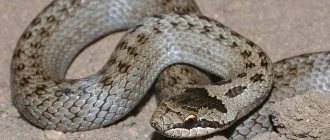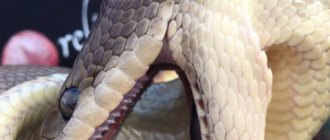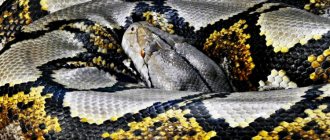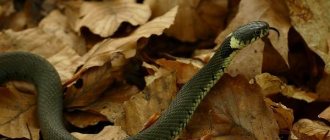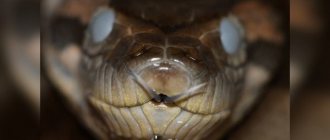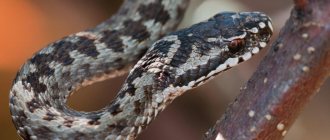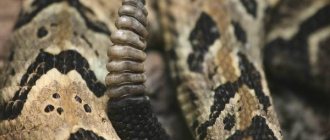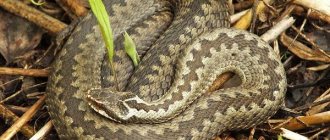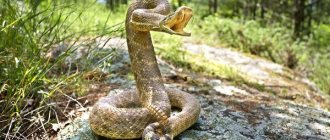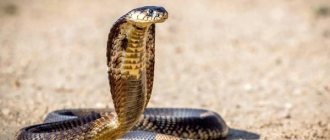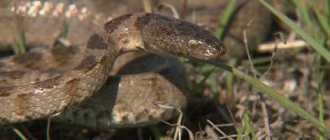Genus Dolichophis
Yellow-bellied Snake
The yellow-bellied snake, also called the Caspian snake, is a fairly large snake, but it is known not for its size, but for its aggressive behavior. The yellow-bellied snake can attack a person and bite until they bleed, but it is worth remembering that the bite of these snakes is not poisonous.
This species of snake is one of the largest European species. There were specimens two and a half meters long, although usually a large snake does not exceed two meters in length. Representatives of the population of this species, living on the islands of the Aegean Sea, are smaller than their continental relatives and do not exceed a meter. Male yellow-bellied snakes are longer than females.
The head of the Caspian snake is small, slightly separated from the body. The muzzle is rounded, the eyes are slightly convex with a round pupil. There are yellow circles around the eyes. The color of the upper body of an adult snake can be yellowish-brown, reddish or cherry-red, olive-brown. Individuals with an almost black color are rarely found. The scales of this species of snake are very smooth.
The Caspian snake belongs to the genus Dolichophis (Latin), to which our next “guest” also belongs.
Red-bellied Snake
The red-bellied snake is a species of the genus Dolichophis. Until recently, these snakes were not identified as a separate species, but were classified as a subspecies of the Caspian snake. It differs from the latter species in some color features, primarily in its reddish belly.
The red-bellied snake lives in the Caucasus, Turkey, and northern Iran; it is also fashionable to meet it in Armenia, Azerbaijan, Georgia and Turkmenistan.
This species of snake lives in a variety of places. It can be found along the coast of valley rivers with dense coastal vegetation, in juniper forests and orchards, on xerophytic mountain slopes at an altitude of 1000-1500 m above sea level.
The red-bellied snake is active during the daytime. After hibernation, it wakes up in March. The mating period lasts from mid-April to mid-May; from mid-June to early July, the female lays 6 to 11 eggs. Young snakes are born in September and immediately reach approximately 33 centimeters in length.
The main prey of this type of snake is lizards; it can also hunt small birds, rodents, and other species of snakes. It tries to hide from enemies in rodent holes; if the snake is unable to hide, then it actively defends itself, making throws towards the enemy and trying to bite him. These attacks are accompanied by a loud hissing sound.
The next species in this genus is Dolichophis jugularis.
Dolichophis jugularis
This species is common in the territories of Southern Europe and the Middle East, namely in Albania, Hungary, Romania, Bulgaria, Macedonia, the islands of the Aegean Sea, Syria, Iraq, Israel, Iran, Lebanon, Kuwait, Jordan.
Representatives of this species can reach 2.5 meters in length, but usually an adult is 1.5 meters long. The color of the species is brown or black with a yellowish tint. Adult representatives of this species have faint lines along the back. Young snakes have short transverse stripes on their backs.
It feeds on lizards and small mammals. It is mainly found on the ground, but also crawls well in trees. It is found in dry places, in fields or on hillsides at altitudes up to 2000 meters above sea level.
Reproduction
At about 2-3 years, snakes reach sexual maturity; females mature later than males. The mating season occurs in mid-late spring, sometimes lasting until the end of summer.
The number of eggs in a clutch varies from 6 to 25; the female places the eggs in the dust of rotten trees, in the grass, near water bodies; the incubation period lasts about a month.
Newborn snakes are a little more than 20 centimeters in length and a little more than 5 grams in weight. They begin molting a week after birth, and then they begin to feed on small mice.
Genus climbing snakes
Now representatives of this genus are very widespread: in North and Central America, Southern and Central Europe, and Asia.
Let's look at some species from this genus.
Island snake
The island snake is found only in Japan and the island of Kunashir. Representatives of the species reach a body length of up to 1.3 meters.
This species lives on the seashore, among stones or surf debris, and can also be found in bamboo thickets or the litter of coniferous forests. This species swims well in both fresh and sea water.
It hunts birds and small mammals; due to hunger, it can also attack Far Eastern frogs. The victim is strangled by wrapping rings around her body and squeezing her, like a boa constrictor.
The most serious enemy of the island snake is the European mink, which was artificially introduced into Kunashir in 1985. Also, active construction leads to a reduction in the species’ natural habitats.
Red-backed snake
A species of snakes up to 80 centimeters long, lives in the south of the Far East, the northern border of the range reaches approximately Khabarovsk and in the northwest to the Burei and Zeya rivers.
It is found along overgrown banks of rivers and standing reservoirs. Swims and dives well, which resembles a snake. This species is absolutely harmless to humans.
The species is ovoviviparous; the female gives birth to 8 to 20 cubs up to 20 centimeters long at the end of September.
Patterned runner
Patterned snake - this species lives in the vast expanses of Asia. It can be found in Mongolia, Korea, northern China, Kyrgyzstan, Tajikistan, Kazakhstan and Southern Siberia, Transcaucasia and further to the northern part of Iran.
The patterned runner reaches a length of one and a half meters. The peculiarity of this species is its very variable coloration. There are monochromatic individuals (melanists), which were previously distinguished into separate subspecies. But as a result of research, it was proven that such color variants are only variants of population variability within the boundaries of one species.
It lives in a wide variety of conditions, it can be found in deserts, steppes, coniferous or mixed forests, juniper woodlands, orchards and vineyards, river valleys, swampy areas, rice fields, and so on. Swims and dives well, climbs tree branches.
The patterned snake's diet is quite varied; it can eat insects, fish, amphibians and other snakes, not to mention small mammals. This species has known cases of cannibalism, in which the victim is swallowed from the head.
In general, the patterned snake is a special forces species in the genus “climbing snakes.”
At the same time, the patterned snake itself can become prey for small predatory mammals, and it can also be eaten by birds (in particular, the steppe eagle). The snake tries to hide from the enemy in a shelter.
In the photo: Anastasia Poklontseva, an employee of the Institute of Ecology of the Volga Basin of the Russian Academy of Sciences, in a snake nursery with her pet, a patterned snake.
Few-scaled climbing snake
The length of representatives of this species does not exceed 150 centimeters. The head is slightly elongated, the body is slender, and the tail is short. Among the representatives of the species there are melanists, that is, darkly colored individuals. There are 4 distinct dark stripes on the sides of the body, but they are absent in melanists. The belly is olive or pink, in melanists it is dark gray with a metallic sheen. Young snakes of this species have a brown color and a clear contrasting pattern that disappears with age. The iris of the eyes is dark red, while in melanists it is black.
The small-scaled climbing snake lives on the Japanese Islands and on the island of Kunashir. It can settle in a wide variety of places: on the seashore, in thickets of bamboo, on the slope of a volcano, near geothermal springs, and so on.
It feeds mainly on frogs and snakes, including an individual of its own species, and sometimes preys on small rodents or birds.
Four-banded climbing snake
The four-striped climbing runner is a fairly large species of runner and can reach 260 centimeters in length. The species lives in the northern and eastern Mediterranean, the steppes of Ukraine, Russia and Kazakhstan, Transcaucasia and Iran.
It feeds on rodents, can eat a young hare, and if lucky, feeds on birds. Juveniles feed on lizards. Easily moves in tree branches in search of bird nests.
It poses no danger to humans and is trying to avoid a meeting. But if she is caught by surprise, she behaves very aggressively, makes sharp lunges towards a potential enemy, trying to bite, and at the same time hisses loudly. The eastern subspecies of this species is the most aggressive.
Amur snake
The Amur snake is one of the most spectacular species of snakes living in Russia.
The back color of adult individuals is dark brown or completely black, often with a bluish iridescent sheen. Against this background, there are rare narrow, oblique, forked stripes of white or yellow color on the sides. The ventral side of this species of snake is yellow, often with dark spots. There are completely black individuals of this species.
The Amur snake lives in a wide variety of natural zones, from steppes to mixed forests. Found in the Far East, Mongolia and Northern China and Korea.
The Amur snake preys on mice, small rats, can catch a bird, destroy a bird's nest and eat eggs. There are known cases when the Amur snake made its way into the chicken coop and ate chicken eggs. Small snakes also eat shrews and mollusks.
These snakes do not shy away from people; they can live in gardens, vegetable gardens and attics of residential buildings.
This is not a conflict snake and, in case of danger, tries to escape, but when driven into a corner, like other types of snakes, it hisses loudly and attacks. An adult large snake can bite seriously.
This snake gets used to people, eats from hands and reproduces in captivity.
Keeping at home
All types of snakes feel great in artificial living conditions; they quickly adapt and get used to people.
Find out what poisonous snakes live in Russia.
To do this, terrarium owners must comply with a number of conditions:
- To stimulate the snake to reproduce, it needs to winterize.
- The snake's daylight hours should be 12 hours. She also needs irradiation to replace the sun's rays. In summer, if the weather is good, the snake can be taken outside to bask in the sun. In winter, the snake, like other snakes, hibernates.
- Within 2-3 weeks, the snake’s daylight hours should be reduced to 8 hours, the night heating should be turned off and food should be stopped, then the daylight hours should be reduced by another 4 hours and the daytime heating should be turned off.
- The snake is then placed in a light-proof, ventilated cage filled with sawdust or well-pressed sphagnum moss. The temperature during wintering should not exceed 17 degrees. You need to bring the snake out of hibernation in the same order. If several snakes live in a terrarium, then females and males are brought out of hibernation separately.
Contents of the corn snake: video
Terrarium
In order for these representatives of the colubrid family to feel comfortable in captivity, the terrarium for them must be of sufficient size and have a horizontal appearance. Each species is distinguished by its specific dimensions, according to which the terrarium is selected.
Depending on the preferences and natural characteristics of a particular type, you need to complete the container. When determining the height of the terrarium for the snake, you need to take into account the presence of lamps for lighting.
Find out if snakes can live without a head.
Required containment conditions:
- Almost all snakes like to be kept in warm conditions, so an appropriate temperature regime in the terrarium will be required: from +28 to +32 degrees during the daytime and from +23 to +25 at night. With the help of heating, it is necessary to provide conditions under which one corner should be warmer than the other.
- It is necessary to monitor air humidity, this will be facilitated by the presence of sphagnum, as well as additional air irrigation. Since almost all snakes can swim, it would be a good idea to install a container of water where the snakes can both swim and soak during the molting period. The water should be changed systematically and have an appropriate warm temperature. Regularly, at least once a week, you need to clean the terrarium.
- Additionally, in the terrarium for a comfortable stay of snakes, it is necessary to provide places and objects for their shelter, as well as for crawling: houses, sticks, flower pots, branches, snags and more.
- The soil in the terrarium will also be useful, for which gravel, sand, paper material, and coconut peels are used.
Feeding
Rodents (mice, rats, hamsters), chickens, quails and other birds are suitable for consumption as food for almost all types of snakes. It is recommended to feed systematically, preferably once every few days. To strengthen the immune system, you can give these snakes vitamins and minerals, crushed eggshells, and calcium.
Home cleaning
To avoid problems with the health of snakes, you need to periodically remove the terrarium from its waste products. Water and soil must be replaced, all equipment must be periodically changed and refreshed.
Find out which snakes are the most dangerous in Africa.
Genus hyerophys
This genus includes 3 species.
Balkan snake
Usually the length of the Balkan snake reaches one meter, rarely 1.3 meters. The color of the snake is olive-brown with dark spots, especially visible in the front part of the body.
The Balkan snake is common in northeastern Italy, Greece, and on the eastern coast of the Adriatic (Albania, Croatia, Montenegro).
It lives in dry rocky places, feeds mainly on lizards and large insects, and less often on small mammals and birds.
Striped snake
The striped snake lives from South-Eastern Kazakhstan to Korea and Southern Primorye. It is also found in China and Mongolia. There have been several sightings of this species near Khabarovsk, but they are considered an accidental introduction.
It can live in a variety of places: from deserts to sea coasts. Like many species of snakes, it feeds mainly on lizards. The striped snake is included in the Red Books of Russia and Kazakhstan.
Yellow-green snake
The yellow-green snake is a fairly large species and can reach a length of 2.2 meters, although the average adult size is 1 meter. It lives in northeastern Spain, Italy, France, Croatia, Slovenia, Switzerland, and also on the island of Malta.
The color of this species corresponds to its name; it is green or yellow with dark transverse stripes on the back and sides. These stripes are wide and uneven, and on the tail they already have the appearance of intermittent, torn ribbons. In some areas of Italy (particularly Sicily), limited populations of completely black individuals live.
The species prefers dry places to live. The diet of the yellow-green snake is practically no different from the diet of other species of snakes.
Nutrition
The snake is an excellent hunter, whose strengths are instant reaction, speed of movement, and keen vision. The energetic pursuit of prey leaves no chance even for nimble lizards, dexterous rodents, which the yellow-bellied can get out of any hole.
The large dimensions of the snake allow it to feed not only on small organisms, but also to feast on adult gophers, hamsters, ground birds, and other snakes. More often, the food supply includes large insects such as locusts, eggs of destroyed bird nests, wood mice, frogs, and shrews.
When hunting, the yellow-bellied snake climbs tall trees, deftly makes its way between branches, and can jump to the ground after prey. The bites of poisonous snakes, such as the viper, which the snake does not disdain, do not cause much harm to it.
In search of food, the yellow belly uses cunning tactics of waiting in ambush. The attack does not manifest itself in snake bites, but in the squeezing of a large victim by the rings of the body until complete immobilization.
The yellow belly simply swallows small prey whole. It is not difficult for a snake to catch up with fleeing prey. The high speed of the yellow belly in pursuit leaves no chance for anyone.
snake poison
Snake venom is a colorless or yellowish odorless liquid consisting of peptides and proteins of varying levels of complexity, enzymes, neurotoxins, lipids, amino acids and other substances.
The toxic effect of snake venom is caused by enzymes that can break down tissue in the human body.
For example, hyaluronidase breaks down connective tissue, and phospholipase breaks down red blood cells.
Snake venom may contain neurotoxins that cause paralysis of the respiratory muscles. As a result, the person dies from suffocation.
Bitten by a yellow snake - what to do
As soon as the snake has bitten, it is necessary to immediately (within 1-2 minutes after the bite) suck out the poison from the wound, pressing it from the edge.
The poison must be spat out immediately. In this way, half of the poison that has entered the tissue can be removed.
However, there is no need to panic. When a person panics, the heartbeat quickens, as a result, the poison spreads faster throughout the body.
Then you need to apply a clean bandage to the wound and send the person to the hospital. It is imperative to remember the distinctive features of the snake so that the doctor selects the correct anti-snake serum.
Population and species status
As already noted, the distribution area of patterned snakes is very extensive, but it cannot be argued that the number of these snakes is large; their density in different regions is most often small. Of course, in some places they feel at ease. For example, on the territory of the Volgograd region, patterned snakes can be found almost everywhere; most of all, they have chosen its eastern and southern parts. Unfortunately, the situation is not so favorable for snakes everywhere; in many regions they are extremely small in number and are beginning to disappear from inhabited areas where they previously existed in sufficient numbers.
This situation arises primarily due to human intervention in the natural snake environment. There are very few untouched areas left where snakes feel safe. People are displacing them from their permanent places of residence by building cities, cultivating fields, draining wetlands, laying transport highways, destroying forests, and worsening the environmental situation in general.
So, we can say with confidence that the status of the patterned snake population in many regions raises concerns among environmental organizations; the number of snakes is steadily declining, and in some places it may even disappear completely, the blame for this is the notorious human factor, so snakes need special protection measures.
